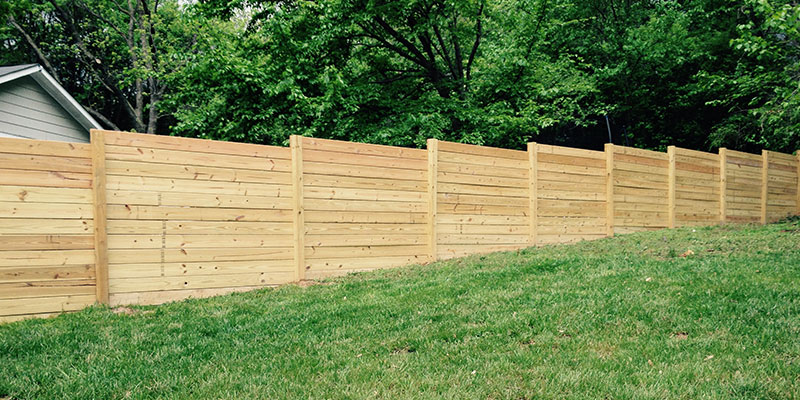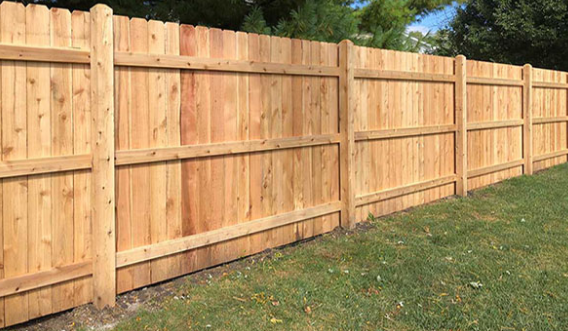Affordable Wood Fence Builders Fort Smith AR: Quality Construction for Every Budget
Affordable Wood Fence Builders Fort Smith AR: Quality Construction for Every Budget
Blog Article
Step-by-Step Guide to Mounting a Timber Fence for Your Home or Residential Or Commercial Property
Mounting a timber fencing can significantly improve both the functionality and visual charm of your residential property. The process calls for mindful preparation and execution to accomplish the desired outcomes. From examining your certain needs to selecting appropriate materials, each step plays an essential role in the overall success of the task. Recognizing these steps not only makes certain a durable installment however additionally adds to long-lasting satisfaction. What complies with is a detailed overview that will certainly give clarity on how to navigate this procedure properly - wood fence installation Fort Smith AR.
Planning Your Fence Installation
When embarking on the installation of a timber fencing, mindful planning is vital to make certain an effective end result. Begin by examining the purpose of the fence-- whether it is for privacy, safety, or looks-- given that this will influence the style and layout. Next, assess the residential property lines, making sure to verify the borders through a survey or title deed to avoid disagreements with neighbors.
Consider regional zoning laws and homeowners' organization guidelines, as these may determine fence elevation, design, and products. It is a good idea to acquire the needed permits before starting job, as this can protect against lawful difficulties later on.
Furthermore, take right into account the terrain and soil problems of your property. Unequal ground might need additional changes throughout installation, while rocky dirt may necessitate specific devices.
Lastly, develop a detailed strategy that includes measurements, the variety of posts, and the spacing in between them. A clear layout will certainly help with the installation process and make certain that you have actually all needed materials on hand. By adhering to these planning steps, you can establish a solid structure for a successful timber fence setup.
Picking the Right Products
Choosing the ideal materials for your wood fence is vital to guaranteeing toughness and aesthetic charm. The most usual kinds of timber made use of for fence consist of cedar, redwood, and pressure-treated pine. Cedar and redwood are normally resistant to decay and bugs, making them outstanding selections for longevity. Their abundant colors and all-natural grain patterns additionally enhance the visual allure of your residential or commercial property.
Pressure-treated pine is an additional preferred option, as it is frequently much more affordable. Nevertheless, it requires routine maintenance and therapy to extend its life-span. When picking wood, think about the climate of your area; for instance, locations with high moisture might take advantage of timber species with higher resistance to dampness.
In addition, you ought to assess the fencing design and objective. A picket fencing may need various product specs contrasted to a personal privacy fencing. Go with thicker boards for structural honesty, especially in high-wind areas. Think about the finish; unattended wood may need staining or securing to secure versus climate elements. By very carefully selecting your materials, you can make certain that your timber fence will stand the test of time while enhancing your home's landscape.
Preparing the Installation Site

Preparing the setup site is a crucial action in making certain the successful building and construction of your timber fence. get more Appropriate prep work not just facilitates a smoother installment procedure but also contributes to the durability and stability of the fencing.

Following, evaluate the surface. Remove any type of barriers such as rocks, roots, or debris that could hinder the setup procedure. Consider leveling it or changing your fencing design accordingly if your site has irregular ground. Furthermore, check for below ground energies by contacting your regional utility firm. This is vital to avoid damage throughout installation and make other certain safety and security.
Installing the Fence Posts

Next, dig holes for each and every blog post, ensuring they are deep sufficient-- typically one-third the height of the message above ground-- to supply security. A deepness of at least 2 feet is a good idea for the majority of fencings. The diameter of the holes should be approximately 3 times the width of the articles.
As soon as your openings are ready, location each article upright right into the marked opening. Make use of a degree to guarantee they are plumb, changing as required. After placing, fill up the holes with concrete mix or jam-packed soil for added support. Allow the concrete to cure as per the maker's instructions, usually 24 to 2 days. Properly installed posts are critical for maintaining the structural stability of the fencing, ensuring it stays upright and safe against environmental anxieties.

Adding Fence Panels and Completing Touches
As soon as the fencing messages are securely set, the following action involves attaching the fencing panels, which will define the boundaries of your property. Begin by placing wood fences Fort Smith AR each panel in between the articles, guaranteeing they are degree and lined up.
Besides panels are affixed, inspect the entire fence for any kind of misalignments or spaces. Make adjustments as required to make sure an uniform look. As soon as pleased with the positioning, think about adding ending up touches. Sand any rough sides or surfaces to stop splinters and enhance visual appeals.
Furthermore, applying a safety sealant or tarnish will certainly enhance the timber's toughness against weather condition elements, extending the life of your fence. With these actions, your timber fence will certainly not only serve its objective properly yet additionally improve the overall appeal of your residential or commercial property.
Final Thought
In conclusion, the effective setup of a wood fencing requires careful planning, choice of proper materials, detailed site prep work, and exact implementation of setup methods. Correct upkeep post-installation further extends the life and appearance of the wood fencing.
When embarking on the installment of a timber fence, careful planning is important to ensure an effective outcome.Selecting the suitable materials for your wood fence is crucial to making certain toughness and aesthetic allure. A picket fencing might require various material specifications compared to a personal privacy fence.With the setup website correctly prepared, the next step includes setting the fencing posts, which serve as the backbone of your wood fence.As soon as the fence articles are firmly established, the next action involves attaching the fence panels, which will certainly specify the borders of your home.
Report this page